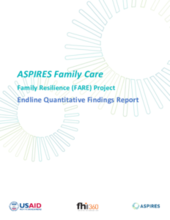Executive Summary
Background
The Family Resilience (FARE) project was funded by USAID’s Vulnerable Children Fund, implemented by AVSI and Retrak, and managed by FHI 360 through the Accelerating Strategies for Practical Innovation and Research in Economic Strengthening (ASPIRES) Family Care project. FARE was developed to help build the evidence base on how to appropriately match economic strengthening (ES) activities with families at risk of family-child separation and with families in the process of reintegrating a previously separated child. It was implemented in two districts in Uganda from January 2016 through March 2018, with most activities beginning in September 2016. FARE was based on a theory of change that a combination of case management, social support and household economic and livelihood strengthening would stabilize highly vulnerable households to facilitate the return of separated children to family care and prevent future family disintegration. The project offered a range of ES and family strengthening services to increase family stability and reduce the likelihood of future separation/re-separation.
ES activities included savings groups (VSLA); cash transfer (CT) or cash transfer plus savings group (CT + VSLA) for a limited number of destitute households; community skills building (Community Skills) for geographically dispersed families; ad hoc support for school fees or materials or apprenticeship only (Other ES) for those households that did not participate in a primary ES activity offered; and nothing (No ES) for those households that could not access or chose not to participate in any economic strengthening activities. In addition to these ES activities, all households received family strengthening activities including, at a minimum, home visiting and counselling by project social workers, and for many, training on parenting skills for caregivers, training on life skills and interactive dialogues for adolescents, community dialogues on topics of interest, and/or recreational activities aimed at promoting psychosocial well-being and fostering a sense of community. Across all activities, FARE found variable interest and availability of participating households; some families engaged in all activities and participated throughout the life of the project, while others chose more limited and/or sporadic participation.
The FARE project offered an opportunity for learning about how to provide these services and how well they worked. This report focuses on the latter and summarizes changes in key indicators related to family-child separation over the course of the project.
Methods
The longitudinal quantitative data on which this report is based were collected by FARE project case managers from beneficiary households before ES activities began (baseline, n=350 at-risk and n=255 reintegrating households) and again at the conclusion of the project, after 12-18 months of project activities (endline, n=292 at-risk and n=188 reintegrating households). Descriptive statistics were generated for more than 20 outcome variables that were selected from across the domains of economic well-being, social/family well-being, and child protection, at both time points. Changes in the average or distribution of responses were calculated and tests of statistical significance were performed, as appropriate. The data are disaggregated according to separation status (at-risk or reintegrating) and the primary economic strengthening activity the household participated in.

